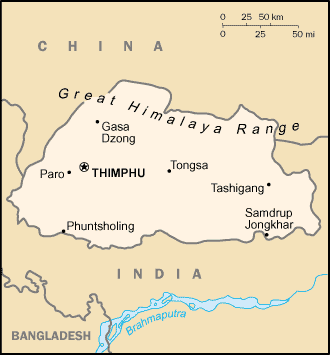Map:

Overview:
In 1865, Britain and Bhutan signed the Treaty of Sinchulu, under which Bhutan would receive an annual subsidy in exchange for ceding some border land. Under British influence, a monarchy was set up in 1907; three years later, a treaty was signed whereby the British agreed not to interfere in Bhutanese internal affairs and Bhutan allowed Britain to direct its foreign affairs. This role was assumed by independent India after 1947. Two years later, a formal Indo-Bhutanese accord returned the areas of Bhutan annexed by the British, formalized the annual subsidies the country received, and defined India's responsibilities in defense and foreign relations. A refugee issue of some 100,000 Bhutanese in Nepal remains unresolved; 90% of the refugees are housed in seven United Nations Office of the High Commissioner for Refugees (UNHCR) camps.
The People:
Population: 2,232,291
note: other estimates range as low as 810,000 (July 2005 est.)
Age structure: 0-14 years: 39.1% (male 452,213/female 420,675)
15-64 years: 56.9% (male 654,109/female 615,431)
65 years and over: 4% (male 45,281/female 44,582) (2005 est.)
Religions:
Lamaistic Buddhist 75%, Indian- and Nepalese-influenced Hinduism 25%
Government Type:
monarchy; special treaty relationship with India
Leader(s) to pray for:
chief of state: King Jigme Singye WANGCHUCK (since 24 July 1972)
head of government: Chairman of the Council of Ministers Lyonpo Yeshey ZIMBA (since 20 August 2004)
Source: The World Factbook
View All Countries